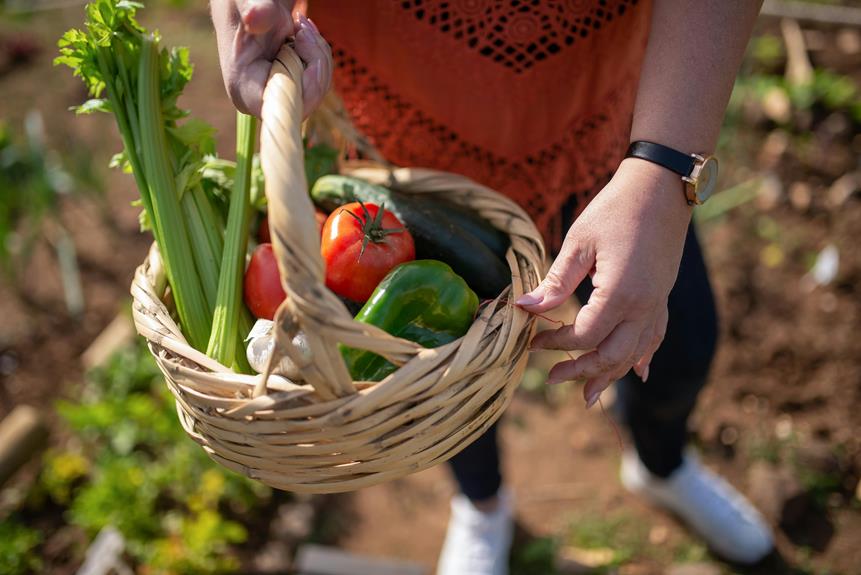You've likely marveled at the sleek, soil-free convenience of an AeroGarden and wondered if you can cultivate your own cucumbers within this compact system. Selecting the right variety is your first step; opt for shorter, bush-type cucumbers designed for small spaces. When setting up, make sure your AeroGarden's light is adequately adjusted to facilitate growth without scorching your plants. As you start on this venture, you'll need to master the art of pollination—a critical step for fruit production that many first-timers overlook. But how exactly do you handle pollination in such a controlled environment? The answer might just surprise you.
Key Takeaways
- Select compact cucumber varieties like 'Spacemaster' that are suitable for confined spaces in AeroGardens.
- Set up the AeroGarden in a location with indirect natural light and maintain water and pH levels as per instructions.
- Program the AeroGarden to provide 14-16 hours of light daily to ensure cucumbers receive enough light for growth.
- Manually pollinate flowers by transferring pollen from male to female flowers to encourage fruit development.
- Harvest cucumbers regularly when they are firm and green to promote continuous production.
Choosing the Right Variety
When selecting cucumber seeds for your Aerogarden, opt for compact or bush varieties that thrive in confined spaces. These types are specifically bred to handle the smaller growing areas and still produce a plentiful crop. You'll find that choosing the right type gives you greater control over your gardening success.
Look for varieties like 'Spacemaster' or 'Bush Crop', which are known for their reduced vine length and abundant yield. These selections are ideal because they don't require the extensive trellising that larger types do, simplifying your setup and maintenance. This means you can focus more on enjoying the growth process and less on adjusting your garden structure.
Moreover, consider the disease resistance of the varieties. Cucumbers can be susceptible to powdery mildew and other common issues, especially in the humid environment of an Aerogarden. Varieties that offer built-in resistance give you an upper hand, ensuring that your efforts aren't wasted on battling preventable illnesses.
Setting Up Your AeroGarden
Now that you've selected the perfect cucumber variety, let's set up your AeroGarden for peak growth. You'll want to make sure everything is perfectly calibrated to give you the most control over the growing environment. First, choose a location for your AeroGarden that's well-lit by natural light but away from direct sunlight which can be too harsh for your cucumbers.
Next, it's time to assemble your AeroGarden unit. Follow the manufacturer's instructions carefully to avoid any mishaps. Once assembled, you'll need to fill the reservoir with water. It's important to use distilled or filtered water to prevent any minerals from tap water from building up in your system.
Here's a quick guide on the initial setup adjustments:
| Setting | Adjustment |
|---|---|
| Light Cycle | 14-16 hours daily |
| Water Level | Fill to the 'Fill to Here' line |
| Nutrient Schedule | Add nutrients at setup & every 2 weeks |
Adjusting these settings ensures your cucumbers receive the best amount of light, water, and nutrients. This setup not only puts you in control but also tailors the environment to promote robust growth and high yields from your cucumbers.
Planting Cucumber Seeds
After setting up your AeroGarden, you're ready to plant your cucumber seeds. Begin by selecting high-quality seeds; this guarantees a stronger start. Your choice of seeds affects the yield and health of your plants, so opt for varieties known for their performance in hydroponic systems.
First, insert the Grow Sponges into the pods in your AeroGarden. These sponges are specially designed to support seed growth by providing the right balance of air and water. Make sure they're seated well.
Next, drop one or two cucumber seeds into the center of each sponge. Planting a couple of seeds per pod increases your chances of germination, but you'll thin them later, keeping only the strongest seedling per pod.
Now, lightly cover the seeds with a few pinches of the provided growing media. This step is essential as it shields the seeds from light, promoting better germination. Don't press down on the media; you need it loose to allow for easy sprouting.
Optimal Light Settings
Once your cucumber seeds are planted, setting the appropriate light conditions will greatly impact their growth. You'll need to harness the power of your Aerogarden's lighting system to maximize the potential of your cucumber plants.
Cucumbers require a lot of light, typically around 14 to 16 hours per day. You can control this precisely with your Aerogarden's built-in timer. Set it once, and it'll handle the rest, ensuring your cucumbers get the consistent light they need without any guesswork from you.
Remember, the importance of light is just as vital. Position the LED lights close enough to provide strong light but far enough to prevent leaf burn. The ideal height is about 4 to 6 inches above the plants.
Adjusting the light settings isn't just a set-it-and-forget-it affair. As your cucumbers grow, you'll need to raise the lights gradually. Keep an eye on how your plants respond.
If you see any signs of light stress such as yellowing or curling leaves, you'll need to adjust the distance or reduce the hours of light exposure.
Adjusting Nutrient Levels
Adjusting nutrient levels in your Aerogarden is vital for healthy cucumber growth. As you begin this task, it's important to remember that you're responsible for the nutrient environment, which can greatly impact the quality and speed of your cucumbers' development.
Firstly, you'll want to monitor the specific nutrient mix Aerogarden provides. This mix is tailored for a hydroponic setup and usually contains the right proportions of nitrogen, phosphorus, and potassium. However, cucumbers are heavy feeders, especially in their flowering and fruiting stages. You might find it beneficial to increase the nutrient concentration slightly above the recommended baseline as your plants mature. This enhances their growth potential and fruit production.
To effectively adjust the nutrient levels, check the electrical conductivity (EC) in your Aerogarden. This measurement tells you how many nutrients are in the water. Aim for an EC level that supports vigorous growth but isn't so high that it causes nutrient burn.
Lastly, observe your cucumbers' response after adjusting the nutrients. Look for signs of nutrient deficiency like yellowing leaves or slow growth, and adjust accordingly. You're in control here, and with careful adjustments, you can maximize your cucumber harvest in the Aerogarden system.
Managing Water Quality
Maintaining excellent water quality is crucial for the health of your cucumbers in an Aerogarden. You've got to keep a close eye on water conditions to guarantee your plants thrive.
Regularly check the water's pH level; cucumbers prefer a range between 5.5 and 6.5. If it strays from this range, you can adjust it using pH up or down solutions, directly giving you control over the growing environment.
You'll also need to monitor the water's nutrient concentration. An electrical conductivity (EC) meter can be invaluable here. It'll tell you when it's time to add more nutrients or dilute the solution if it's too concentrated. This prevents nutrient burn, a common issue that can stunt growth and reduce yield.
Additionally, refresh the water every two weeks. This isn't just about adding fresh water but completely changing it to prevent the buildup of harmful salts and bacteria. This practice keeps your system clean and your cucumbers healthy.
Pollination Techniques
To guarantee that your Aerogarden cucumbers bear fruit, you'll need to manually pollinate the flowers. Since there aren't any natural pollinators like bees buzzing around indoors, you're in charge of this important step. Don't worry; it's simpler than it sounds, and you've got this under control.
Start by identifying the male and female flowers on your cucumber plants. Male flowers are typically borne first and are attached by thin stems without any swellings at the base. Female flowers, on the other hand, have a small bulge beneath them, which is the developing fruit.
Once you've got your bearings, take a small paintbrush or a cotton swab to transfer pollen. Gently brush the center of the male flower to collect the yellow pollen grains. Carefully move to the female flower and dab the pollen onto the stigma in the center of the bloom. It's a delicate process, but you're effectively taking over the role of bees in your garden.
Repeat this process every two to three days to make sure all your flowers are pollinated. With consistent attention, you'll maximize your yield, transforming those tiny blooms into full-grown cucumbers ready for your next salad or snack.
Pruning and Maintenance
After mastering pollination, you'll need to focus on pruning and maintaining your cucumber plants to guarantee they thrive in your Aerogarden. Pruning isn't just about keeping your plants looking good; it's essential for managing energy and resources. You'll want to remove any dead or dying leaves as soon as you spot them. This helps prevent disease and allows your plant to focus its energy on producing vibrant cucumbers.
Here's a quick guide to help you keep track:
| Action | Benefit |
|---|---|
| Remove dead leaves | Prevents disease, improves air circulation |
| Trim excess foliage | Enhances light exposure to lower leaves |
| Pinch off non-fruiting branches | Directs energy to fruit-bearing branches |
| Regularly check plant health | Early detection of potential issues |
| Adjust plant positioning | Ensures even light distribution |
Make sure you're also checking the moisture levels frequently. Your cucumbers will need a consistent amount of water, but be careful not to overwater. Too much water can lead to root rot, which is detrimental. With these practices, you're in full control, shaping your Aerogarden to be as productive as possible. Remember, regular maintenance not only promotes growth but also maximizes your yield.
Troubleshooting Common Issues
Despite your best efforts, you might encounter some common issues while growing cucumbers in your Aerogarden. Recognizing and addressing these problems quickly is crucial to maintaining control over your garden's success.
Firstly, if you notice yellowing leaves, it's often a sign of overwatering. Check the water level frequently—cucumbers need moisture, but excessive water can harm them. Adjust your Aerogarden's watering settings accordingly to achieve the right balance.
Another common issue is poor pollination. Since Aerogardens are indoors, natural pollinators like bees aren't available. You'll need to manually pollinate your plants. Use a small brush or cotton swab to transfer pollen from one flower to another. This stimulates fruit production and ensures your cucumbers develop properly.
Sometimes, plants mightn't thrive due to inadequate nutrients. Your Aerogarden kit includes specific nutrients, but they must be used precisely. Follow the recommended feeding schedule and be cautious not to over or under-do it. Too much can burn the plants, and too little can stunt their growth.
Lastly, watch out for pests, even indoors. If you spot signs of infestation, such as tiny holes in the leaves or wilting, react swiftly. Use an organic pesticide or introduce beneficial insects like ladybugs to your Aerogarden. Taking these steps will help you regain control and keep your cucumber plants healthy and productive.
Harvesting Your Cucumbers
Once your cucumbers reach the desired size in your Aerogarden, it's time to start harvesting. You'll want to be proactive about this step to guarantee optimum freshness and flavor. Ideally, cucumbers should be about 6 to 8 inches long and uniformly green. Waiting too long can lead to overripe, bitter fruit, which isn't what you're aiming for.
Use a sharp pair of pruning shears or scissors to cut the cucumber from the vine. Don't pull or twist as this can damage both the plant and the fruit. Make your cut close to the main stem, and handle the cucumber gently to avoid bruising.
Harvesting regularly encourages your Aerogarden to produce more cucumbers. If you notice a slowdown in production, check if there are fruits hidden beneath the foliage that you've missed. These can be over-ripening, sapping energy from the plant that could be directed towards new growth.





Konnichiwa! (Hello!) I'm Pat Tokuyama, a Japanese tofu cookbook author, who travels for music, food, and adventure. If you like Japanese tea, checkout some of the newestorganic japanese tea, matcha bowls and noren and more!
** Curious about the Plant Based Japanese Cooking Club? ** Learn more here!